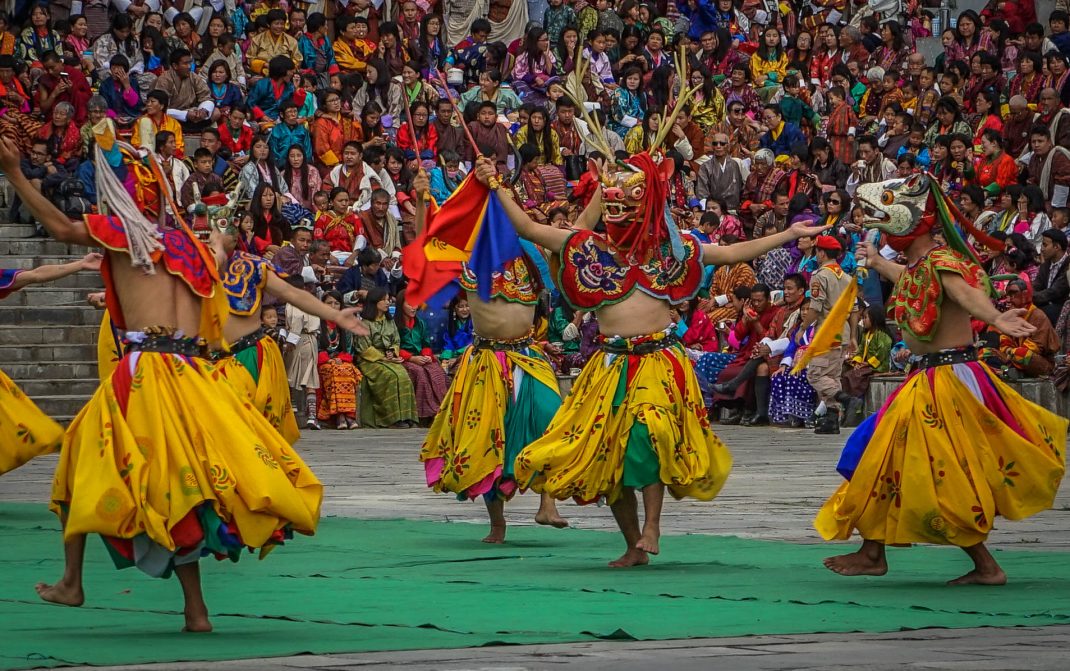The Thimphu Festival, held in the capital city of Bhutan, Thimphu, is an annual event steeped in tradition. It serves as a reminder of the deep-rooted culture and beliefs that have flourished in the heart of the Himalayas for centuries. This celebration allows visitors a rare opportunity to witness the Bhutanese way of life, which is deeply influenced by Buddhism and the nation’s commitment to preserving its cultural heritage.
The festival typically takes place in autumn, and the exact dates are determined by the Bhutanese lunar calendar. It coincides with the auspicious time of Guru Rinpoche’s arrival in Bhutan, commemorating the great saint who introduced Buddhism to the country. The festival usually lasts for several days, and each day is filled with an array of spectacular events, masked dances, and religious rituals.
Spiritual Upliftment
Bhutan is often referred to as the “Land of the Thunder Dragon,” and its unique blend of Buddhism and spirituality plays a significant role in the lives of its people. The Thimphu Festival is a reflection of this spiritual significance. The dances and rituals performed during the festival have profound meanings and are intended to bring blessings, ward off evil spirits, and purify the surroundings.
The dances, known as cham dances, are performed by masked monks who have undergone rigorous training to perfect the intricate steps and elaborate costumes. Each cham dance tells a story from Bhutanese history or mythology, and the colorful masks and costumes add to the spectacle. The dances are accompanied by traditional music played on ancient instruments, creating an ambiance that is both spiritually uplifting and visually captivating.
Community and Togetherness
The Thimphu Festival is more than a religious celebration; it’s a unifying event that brings the community together. It’s a time when Bhutanese families from all walks of life come to celebrate and pay their respects to the divine. The festival grounds become a vibrant gathering place where locals don their finest attire, and it’s common to see families dressed in their traditional best.
In addition to the spiritual aspects, the Thimphu Festival is a celebration of togetherness and community spirit. It’s a time for families and friends to reunite, exchange blessings, and engage in the festivities. Visitors are welcomed with open arms and often find themselves invited to join in the celebrations, further enhancing the sense of belonging and camaraderie.
Cultural Immersion
For travelers seeking an immersive cultural experience, the Thimphu Festival is an ideal destination. It provides a unique opportunity to delve into the heart of Bhutanese culture and tradition. As the festival is celebrated with immense enthusiasm and zeal, you can partake in various aspects of Bhutanese life, from the vibrant music and dance to the delectable local cuisine.
While in Thimphu during the festival, visitors can explore the bustling Centenary Farmers’ Market, where farmers from all over the region come to sell fresh produce, traditional crafts, and handmade goods. It’s an excellent place to interact with locals and sample Bhutanese delicacies. The market, with its colorful stalls and lively atmosphere, provides an authentic experience of everyday Bhutanese life.
A Window into Bhutanese History
The Thimphu Festival is a living testament to Bhutan’s rich history and heritage. Each dance and ritual has a story to tell, often tracing its origins back to significant events in Bhutanese history or ancient legends. By attending the festival, visitors can gain insight into the historical events that have shaped the country’s culture and beliefs.
One of the most anticipated events during the Thimphu Festival is the unveiling of the thongdrol, a massive scroll painting depicting the eight manifestations of Guru Rinpoche. The thongdrol is unveiled at the break of dawn on the final day of the festival and is believed to wash away the sins of those who view it. It is an awe-inspiring moment, and the large, beautifully detailed scroll is a stunning representation of Bhutanese artistry and spirituality.
A Feast for the Senses
The Thimphu Festival is a sensory delight. The vibrant colors of the dancers’ costumes and masks, the hypnotic rhythms of the traditional instruments, and the fragrant incense create a sensory tapestry that leaves a lasting impression. The visuals, sounds, and aromas experienced during the festival are a feast for the senses, making it an unforgettable and immersive cultural experience.
The festival is also an opportunity to savor traditional Bhutanese food, such as ema datshi (chili and cheese stew), momos (dumplings), and a variety of flavorful dishes. Bhutanese cuisine is a reflection of the country’s unique culture, and sampling these dishes during the festival provides an authentic culinary experience.
The Unique Environment of Thimphu
Thimphu, the capital of Bhutan, adds to the festival’s allure. It is one of the few world capitals without traffic lights, and the city’s commitment to preserving its traditions and environment is apparent in its architecture and way of life. It provides a tranquil setting for the festival, with a backdrop of rolling hills and majestic mountains. This unique environment allows visitors to experience the festival in a serene and unspoiled natural setting.

